Dwarka is an ancient city and a municipality of Devbhoomi Dwarka district in the state of Gujarat in northwestern India. It is located on the western shore of the Okhamandal Peninsula on the right bank of the Gomti River. In 2011 it had a population of 38,873. Dwarka is one of the foremost Chardhams, four sacred Hindu pilgrimage sites, and is one of the Sapta Puri, the seven most ancient religious cities in the country. Dwarka is often identified with the Dwarka Kingdom, the ancient kingdom of Krishna, and is believed to have been the first capital of Gujarat.
History
Early History
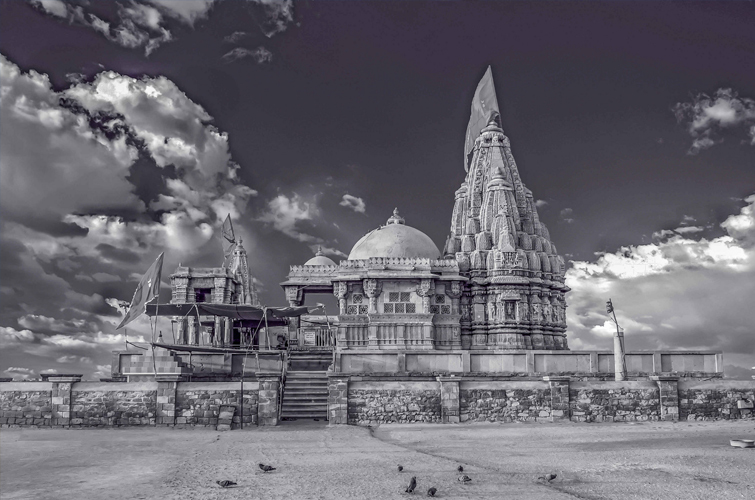
In 200 AD, King Vasudev II of Dwarka was defeated by Mahakshatriya Rudradama. Upon the death of Rudradama, his wife,
Queen Dheeradevi, invited his brother Pulumavi, seeking guidance to rule. Rudradama had embraced the Vaishnava religion
and worshipped Krishna at Dwarka. Vajranabha, his successor, built a chhattri (an umbrella type monument) and deified
an idol of Krishna in it.
In 1473 the Gujarat Sultan Mahmud Begada sacked the city and destroyed the temple of Dwarka.The Jagat Mandir or the
Dwarakadhisa temple was later rebuilt.Vallabha Acharya retrieved an idol of Dwarkadhish, which was revered by
Rukmini. He hid it in a stepwell, known as Savitri vav, during the Muslim invasion, before moving it to Ladva village.
In 1551, when Turk Aziz invaded Dwarka, the idol was shifted to the island of Bet Dwarka.
Dwarka, at the mouth of the Gulf of Kutch, on the western shore of the Okhamandal Peninsula, is on the right bank of the
Gomti River which rises from the Bhavda village at a place known as Mul-Gomti, 10 kilometres (6.2 mi) to the east. It is
now under the newly formed district of Devbhoomi Dwarka at the western end of the Saurashtra (Kathiawar) peninsula,
facing the Arabian Sea.The Gomti River was a harbour until the 19th century.
According to the Köppen-Geiger classification, Dwarka has a subtropical desert/low-latitude arid hot climate. The
Holdridge life zones system of bio-climatic classification identifies Dwarka in or near the subtropical thorn woodland
biome.On the basis of 40 years of climatic data:The average annual rainfall is 310 millimetres (12 in) spread over a
rainy period of 29 days with rainfall limited to the months of June to September; the average maximum temperature is
31 °C (88 °F) with a maximum of 42 °C (108 °F) and an average minimum temperature of 15 °C (59 °F) with a minimum of
5 °C (41 °F); the average annual relative humidity is 72%, with a maximum of 80%.
Most of the revenue of Dwarka is derived from tourism, due to it being a site for pilgrims.It is a producer of
agricultural produce such as millets, ghee (clarified butter), oilseeds, and salt, which are transported from its port.
A long term development plan was proposed in 2011 with investment of ?830 million (US$12 million) to refurbish the city
of Dwarka and to build a bridge connecting the city with Okha and Bet Dwarka.A wind farm power generation of 39.2 MW,
operated near Dwarka by the AES Saurashtra Windfarms Pvt Ltd (ASW), is now run by Tata Power Renewable Energy Ltd
(TPREL).Dwarka's industrial activity mainly centres around cement production.Dwarka's economy relies heavily on
pilgrims and tourism but is supplemented by the production of millets, ghee (clarified butter), oilseeds, and salt,
which are transported from its port. A long-term development plan was proposed in 2011 by the Government of Gujarat,
with investment of ?830 million (US$12 million) to refurbish the city of Dwarka and build a bridge connecting the city
with Okha and Bet Dwarka. Janmashtami is the main festival that is celebrated during August and September. Sharda Peeth
Vidya Sabha is an educational society sponsored by the Sharda Peeth, Dwarka which runs an arts college in Dwarka. Dwarka
was selected as a heritage city by the Indian government's Heritage City Development and Augmentation Yojana (HRIDAY)
initiative.
Dwarkadish Temple, popularly known as the Jagat Temple, was built in the 16th century. The original Dwarkadish Temple was
built by the great grandson of Lord Krishna, King Vajranabha. It is a 5 storied temple constructed using sand and
limestone. This temple is located in the middle of the town, with a 70.5 metres high spire.
Somnath Temple in Dwarka represents one of the 12 Jyotirlingas of Lord Shiva. The word Somnath refers to the protector of
Moon God. This temple is situated in Prabhas Kshetra near Veraval, which is located along the western coast of Gujarat.
Nageshwara Jyotirlinga Temple, also called the Nagnath temple, is located in the outskirts of Dwarka, in Gujarat. It is a
famous Lord Shiva Shrine in India, which is situated between Gomati Dwarka and Beyt Dwarka Island. Nageshwara is one of
12 Jyotirlingas mentioned in the Shiva Purana.
Beyt Dwarka is an island, situated at a distance of 30 km from the main town. This island is surrounded by few temples,
white beach and coral reefs. The main temple at Beyt Dwarka is that of Lord Krishna, which is believed to be located at
a site that was once the residence of Lord Krishna and His family. This temple is over 500 years old and was built by Sri
Vallabhacharya.
Rukshamanee Mandir is dedicated to the beloved wife of Lord Krishna, Devi Rukmani. Among all His 16,108 wives, Devi
Rukmani was Lord Krishna’s favourite. The Rukshamanee Mandir, which is also known as Rukmani Temple, features varied
paintings of the 12th century on its walls. These paintings capture the time spent by Lord Krishna and Devi Rukmani.
The Jagad Mandir at Dwaraka, also known as Dwarakadheesh Temple, is one among the four pilgrimage sites included in the
Char Dham. Considered to be a holy site where Lord Krishna ruled and lived, the original temple was built by Krishna's
grandson, Vajranabha. The present temple was over the years by several rulers.
Dwarka Lighthouse was constructed at Rupen Creek during the early 19th century. In order to lift a lamp, a flag mast was
posted at the port, which thereafter served as a lighthouse. In 1866, eighteen metres tall square tower was constructed
at this site, along with an installation of an oil wick lamp.
Janmashtami is the main festival that is celebrated during August and September[44] with great fervor and piety as it was
in the prehistoric times the abode of Krishna. The festival is marked by several night long celebrations to mark the
birth of Krishna. Bhajans and sermons are part of the festivities. At midnight there is reenactment of Krishna's
childhood in the form of Garba and Raas dances. On this occasion, the local boys create a pyramid and a young boy in the
costume of Krishna climbs up this pyramid to strike a pot holding butter, an act which Krishna had mischievously performed
with the gopis.
The underwater ancient city off the coast of Bet Dwarka has been proposed to be developed as a scuba diving site. This
project is a joint initiative of Adventure Sports Ltd (ASL) and the Government of Gujarat, with investment of ?13 crore
(US$1.9 million). This is believed to be the first effort anywhere in the world to exploit a submerged city for tourism.
Water and beach sports are also being promoted by the state government, and there are proposals to further promote aero
and submarine sports.
An epigraphic reference ascribed to Garulaka Simhaditya, the son of Varahdas, the king of Dwarka, is inscribed on a
copper plate dated to 574 AD, found in Palitana. The Greek writer of the Periplus of the Erythraean Sea referred to
a place called Baraca, which has been interpreted as present-day Dwarka. A reference made in Ptolemy's Geography
identified Barake as an island in the Gulf of Kanthils, which has also been inferred to mean Dwarka.
One of the four dhams (religious seats), which were founded by Adi Shankaracharya (686–717 AD) at the four corners of the
country, was established as a monastic centre at a time when mainstream Hinduism had still not been accepted; it forms
part of the Dwarka temple complex.In 885 AD, the temple was renovated by Nrushinhaashrma, head of the
Shankaracharya pitha .
Middle Ages to Present

Dwarka, along with the Okhamandal region, was under the rule of Gaekwad of Baroda state during the Indian rebellion of
1857. A war broke out at Okhamandal in 1858 between the local Vaghers and the British. The Vaghers had won the battle and
ruled until September 1859. Later, after a joint offensive of the British, the Gaekwads, and other princely state troops,
the Vaghers were ousted in 1859. During these operations, led by Colonel Donovan, the temples at Dwarka and Bet Dwarka
suffered damage and were looted. A complaint of atrocities by the British was made by the local people of Jamnagar,
Porbander, and Kutch, which led to their restoration.In 1861, Dwarakadheesh Temple was renovated by Maharaja Khanderao
and the British, who refurbished the shikara. Maharaja Gaikwad of Baroda added a golden pinnacle to the shikara in 1958
during a refurbishment by Shankaracharya of Dwarka. Since 1960, the temple has been maintained by the Government of
India.
Dwarka is one of 12 heritage cities across the country selected under the Heritage City Development and Augmentation
Yojana (HRIDAY) scheme of the Government of India to develop civic infrastructure.The Sudama Setu, a bridge over
the Gomti River connecting mainland Dwarka with Panchkui island was opened in 2016.
Geography and Climate
Geography
Dwarka is well connected to the rest of India by air, rail, and road transport. It is 131 kilometres (81 mi) by State
Highway 947 from Jamnagar, where there is a domestic airport.The Dwarka railway station is on the broad gauge
railway line that runs from Ahmedabad to Okha at a distance of about 137 kilometres (85 mi) from Jamnagar. Dwarka is 217
kilometres (135 mi) away from Rajkot and 378 kilometres (235 mi) from Ahmedabad.
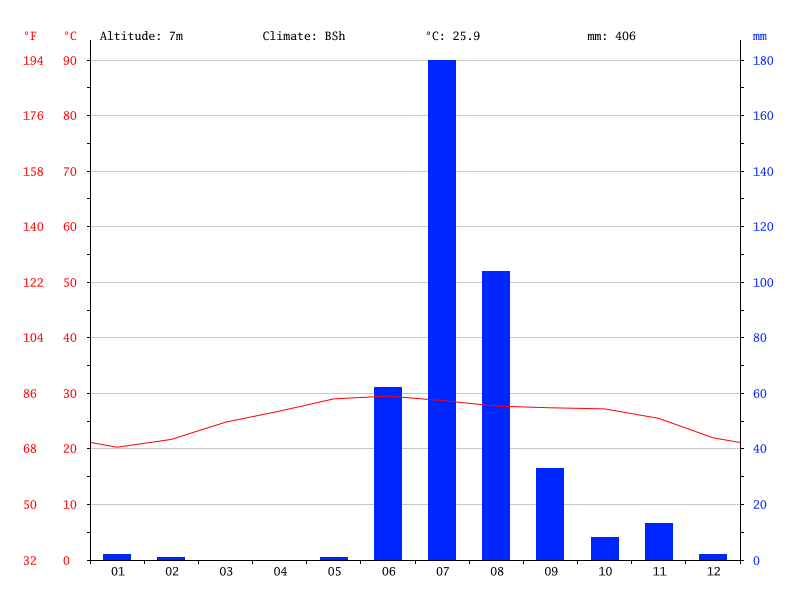
Climate
Economy
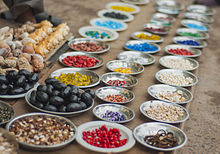
Tourists Places in Dwarka
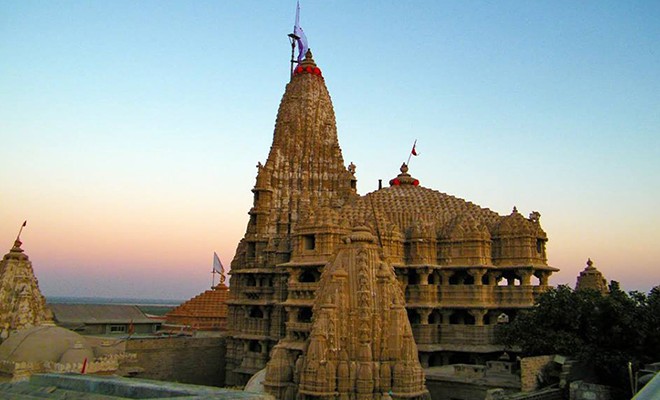
Dwarkadish Temple
On the top of the temple dome, there is a 24 metres long multicoloured flag, with symbols of moon and sun on it. The
temple has a platform area of 1800 sq. feet and comprises a shrine, which is well supported by 60 pillars. These pillars
are made of sandstone and granite, which render extra strength to the shrine.
Tourists have to climb around 56 steps, representing the 52 administrative divisions of the Yadava kingdom and remaining
four represents Krishna, Balaram, Pradyuman and Anirudhha, respectively. This Jagat Mandir has two main entrances, one
facing north and another facing the south. The north entrance, which is also the main entrance to the temple, is known
as the 'Moksha Dwara' (Door to Salvation). This entrance also leads towards the town market near the temple.
The south entrance of the temple is known as the 'Swarga Dwara' (Gate to Heaven). This entrance opens towards the Gomati
River, where devotees are required to take a bath before entering the temple. The main deity in the temple is Lord
Dwarkadish or Lord Krishna. There is also a statue of four-armed Vishnu known as Trivikrama.
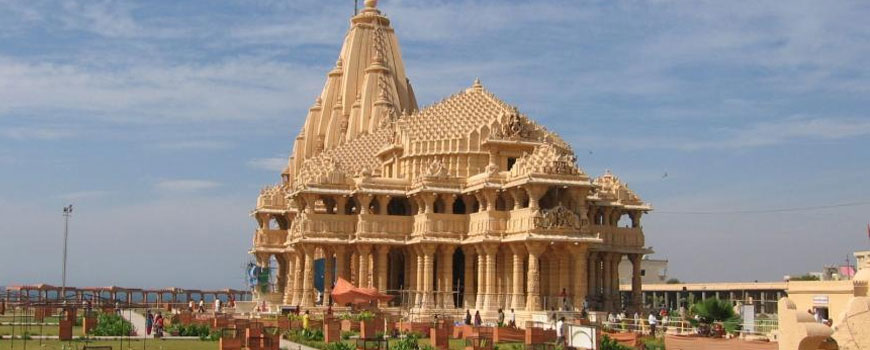
Somnath Temple
The Somnath temple have been destroyed six times and rebuilt six times. Thus, the temple is also known as 'The Shrine
Eternal'. It is believed that Soma or the Moon God built this temple in gold, the demon king Ravana built it in silver
and Lord Krishna built it in wood.
The final reconstruction of the temple started in November 1947, under the leadership of Sardar Vallabhbhai Patel. This
temple is built in the famous Chalukya architectural style or Kailash Mahameru Prasad style, which is a clear reflection
of the Sompura Salats skills.
Lord Shiva was so pleased by the prayers of Moon God that He decided to rest in this temple as a Jyotirlinga for eternity.
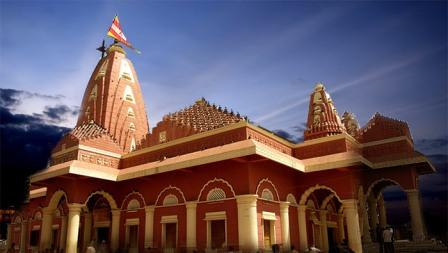
Nageshwara Jyotirlinga Temple
The lingam enshrined in this temple is that of Nageshwara Mahadev, symbolising protection from all kinds of poison. The
highlight of the temple is the Nageshwara Mahadev Shiva Lingam, which is a giant statue.
This temple is unique in the sense that the Shiva Lingam faces to the south and the Gomugam faces towards the east.
According to the Shiva Purana, Lord Shiva started residing in the temple after he killed a demon named Daaruka. This
place was thus named after this demon as Darukavana.
Shivaratri festival is celebrated in grand style at this temple, which is attended by innumerable devotees from across
the world. Tourists can take rides in buses and auto rickshaws to visit this temple, which is around 10 km from the main
town.
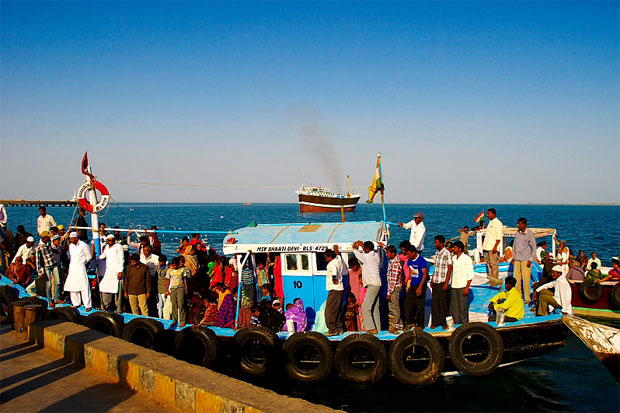
Beyt Dwarka
In addition to this, Beyt Dwarka features temples of Vishnu, Radha, Lakshmi, Satyabhama, Devaki and Jambavati. There is a
narrow street which leads to these temples that are crowded by vendors selling local crafts, idols, cassettes, coconut
and seashells.
This island is also known as Beyt Shankhodhar, which was one of the main ports of the town, before the development of
Okha. The beach is popular among travellers for its rich marine life, marine excursions, water sports, camping and
picnics.
For visiting Beyt Dwarka, travellers have to first reach Okha port jetty by rail or road, which is around 32 km from the
town. From there, tourists can hire a ferry or small boat to visit Beyt Dwarka, which is just 5 km from Okha.
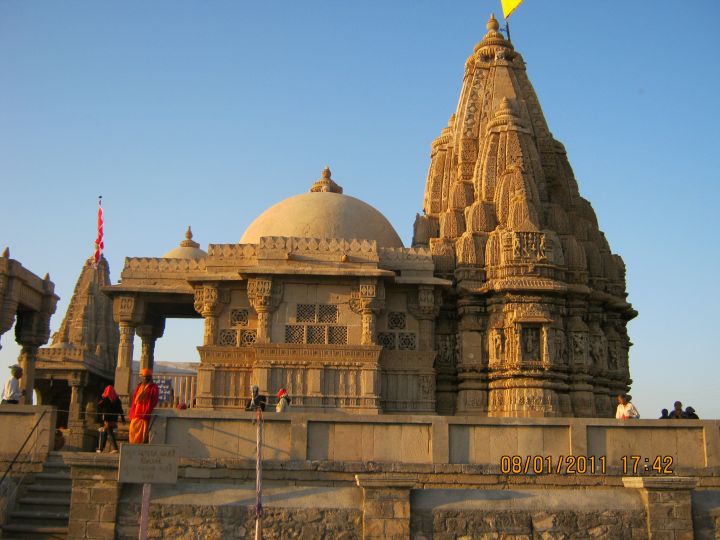
Rukshamanee Mandir
The temple is situated about 1.5 km from the main town, on the Okha highway. It is located on the banks of Bhagirathi
River, which can be seen while travelling to Beyt Dwarka. The Mandir comprises a beautiful marble deity of Devi Rukmani,
with four hands or Chaturbhuja. These four hands hold Shanka, Chakra, Gada and Padma, which symbolise her being
reincarnation of Goddess Maha Lakshmi.
Due to the curse spelled by Rishi Durvasa to Devi Rukmani, this Rukshamanee Mandir is placed away from the main
Dwarkadish Temple in the town. Tourists can travel to this temple by local buses, auto rickshaws or by foot.
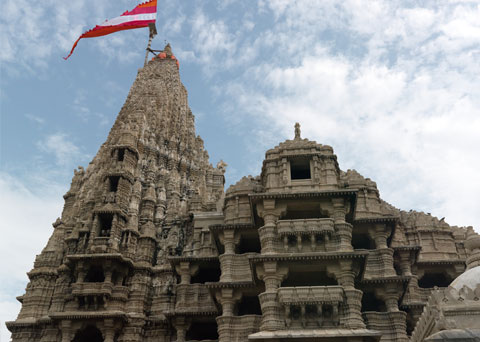
Jagad Mandir
Built in Chalukyan style of architecture, what stands out are the two temple towers or shikhars, one more than 50 m in
height. The temple is five storied and has seventy two intricately designed pillars.
The idol of Dwarakadheesh is made from a shiny black stone. The temple has a 52 yard long flag which can be seen as far as from 10 km.
Recognized as a UNESCO World Heritage Site, this temple is visited by hundreds of followers from all over India.
The temple timings are from 6.30 am to 1.00 pm and 5.00 pm to 9.30 pm.
One can also visit Gomati Ghat, Sri Adhishankara Dwaraka Peetham, Sri Kalyana Narayana Perumal Temple and Hari Kund which
are situated at walk able distances from the temple.
The best time to visit is during Janmashtami which is celebrated with great enthusiasm and color.
Jagad Mandir is easily accessible by road.

Dwarka Lighthouse
The present day tower measures around 43 metres in height and was constructed between 1960 and 1962. On 15th July 1962,
this lighthouse was inaugurated by the then transport minister Mr. Raj Bahadur.
In addition to the tower, a RCC Baffle wall was constructed at the site for installing the sound horn equipment and
vibrators that can work as fog signals. In 1988, this fog signal service was terminated.
Further, on 15th April 1964, this lighthouse was commissioned with other advanced facilities. From this lighthouse,
travellers can see the panoramic sight of sunset. This lighthouse is located at a distance of 35 km from the main town
and features serene atmosphere that is perfect for relaxing.
Culture and Sports

Culture
Sharda Peeth Vidya Sabha is an educational society sponsored by the Sharda Peeth, which runs an arts college in Dwarka.
The city is also home to the N.D.H. High School and P.V.M Girls' High School.
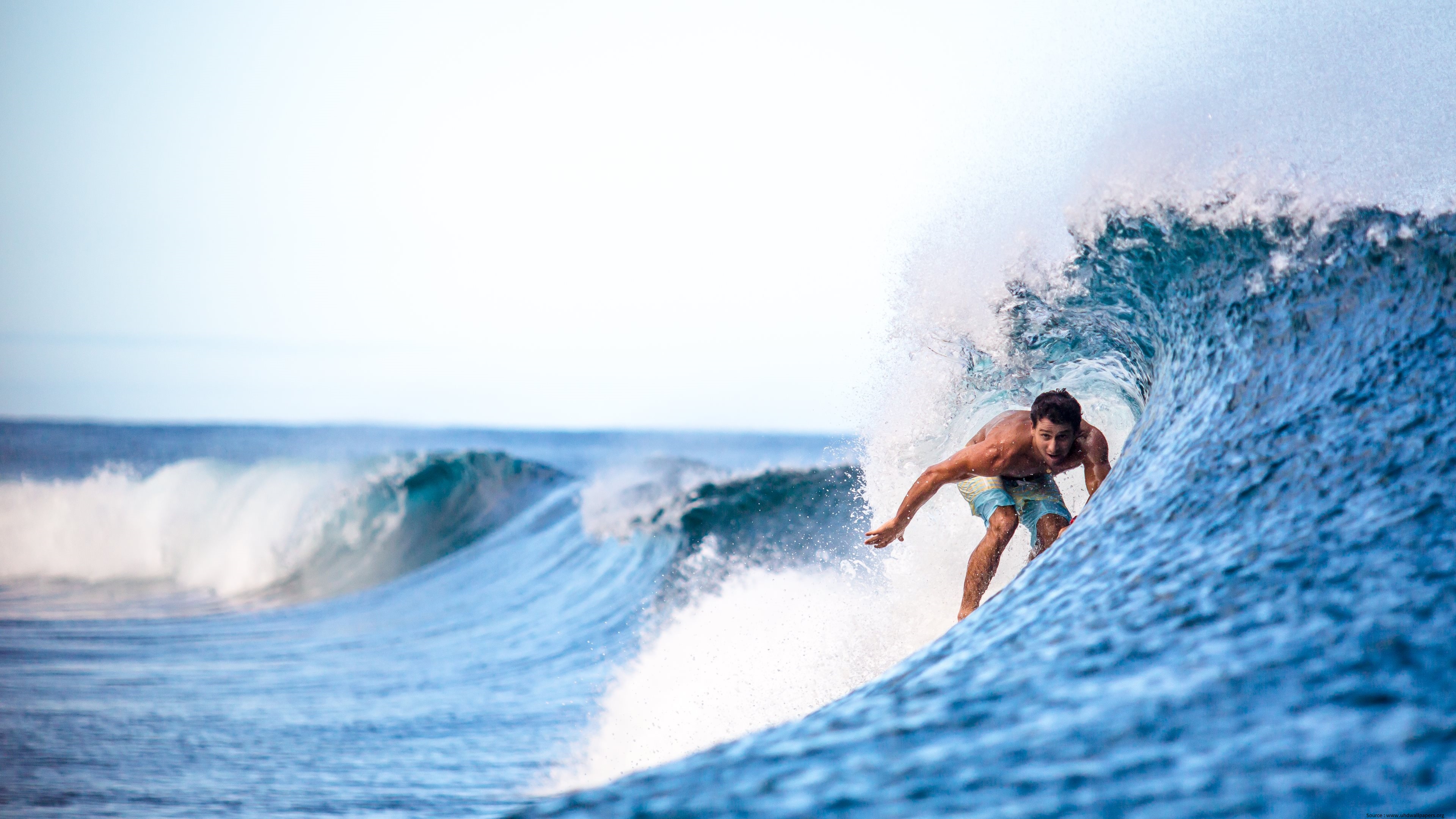
Sports
